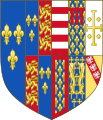Датотека:Arms of Margaret of Anjou.svg
Изглед

Величина PNG прегледа за ову SVG датотеку је 408 × 477 пиксела. 5 других резолуција: 205 × 240 пиксела | 410 × 480 пиксела | 657 × 768 пиксела | 876 × 1.024 пиксела | 1.752 × 2.048 пиксела.
Оригинална датотека (SVG датотека, номинално 408 × 477 пиксела, величина: 1,41 MB)
Историја датотеке
Кликните на датум/време да бисте видели тадашњу верзију датотеке.
| Датум/време | Минијатура | Димензије | Корисник | Коментар | |
|---|---|---|---|---|---|
| тренутна | 07:05, 19. фебруар 2015. |  | 408 × 477 (1,41 MB) | Sodacan | fix Bar quarter |
| 12:56, 5. август 2013. |  | 408 × 477 (1,43 MB) | Sodacan | size | |
| 12:28, 5. август 2013. |  | 408 × 465 (1,43 MB) | Sodacan | sizing | |
| 08:47, 16. јул 2013. |  | 436 × 465 (1,45 MB) | Sodacan | User created page with UploadWizard |
Употреба датотеке
Следећа страница користи ову датотеку:
Глобална употреба датотеке
Други викији који користе ову датотеку:
- Употреба на af.wikipedia.org
- Употреба на ar.wikipedia.org
- Употреба на arz.wikipedia.org
- Употреба на ast.wikipedia.org
- Употреба на azb.wikipedia.org
- Употреба на be.wikipedia.org
- Употреба на bg.wikipedia.org
- Употреба на ca.wikipedia.org
- Употреба на cs.wikipedia.org
- Употреба на da.wikipedia.org
- Употреба на de.wikipedia.org
- Употреба на el.wikipedia.org
- Употреба на en.wikipedia.org
- Употреба на eo.wikipedia.org
- Употреба на es.wikipedia.org
- Употреба на eu.wikipedia.org
- Употреба на fa.wikipedia.org
- Употреба на fr.wikipedia.org
Још глобалног коришћења ове датотеке.
